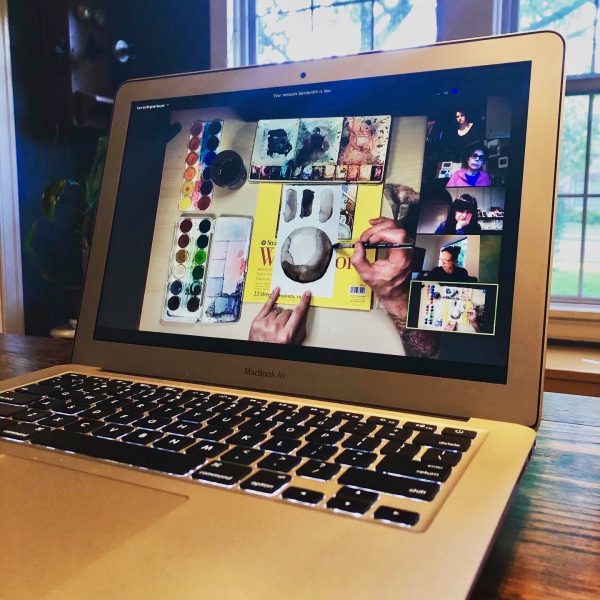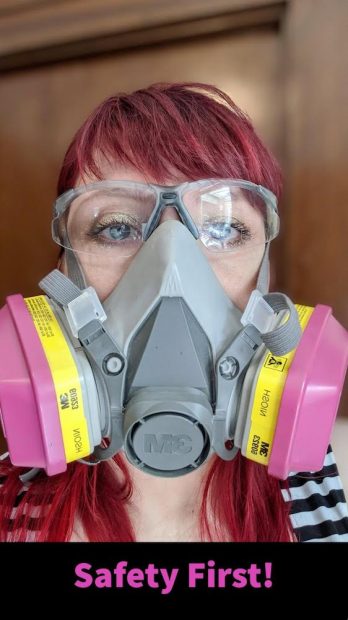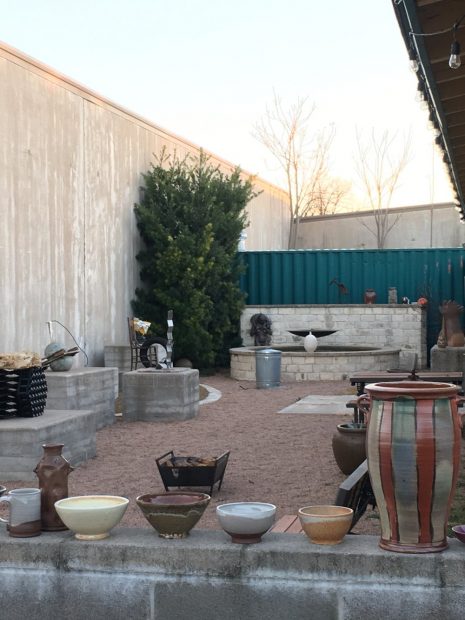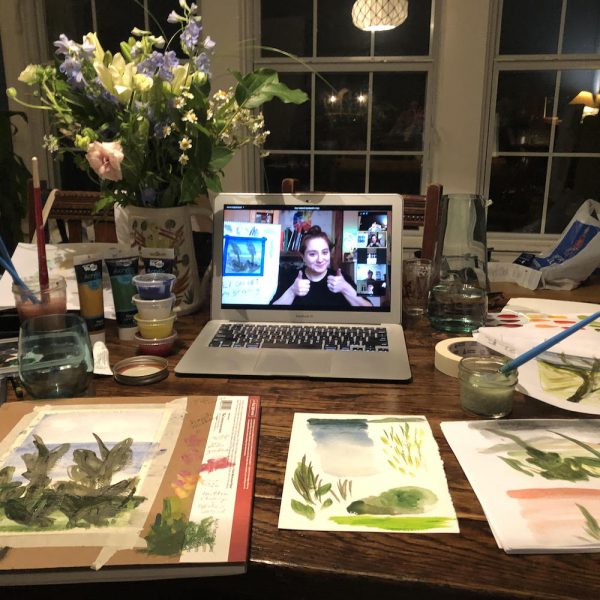Among the myriad of arts communities affected by the COVID-19 pandemic are makerspaces, arguably some of the least socially-distant friendly arts spaces, built for sharing and collaboration, and people working in close proximity with shared tools, all day, every day.
I recently spoke with a handful of Texas makerspaces to see how shutdowns have affected their spaces, the communities they serve, and the mixed experiences of going fully digital.
HOUSTON
Houston-based TX/RX Labs, a nonprofit which offers classes, job training, youth education, tool and space rental, was producing ad-hoc personal protective equipment (PPE) starting in March, but the supply chains have leveled out and there’s no longer a need for non-regulated PPE, says Roland von Kurnatowski, president of TX/RX.
“The companies that mass produce masks have come online, so producing masks by hand isn’t really cost effective anymore,” says Von Kurnatowski. “So we’ve stopped doing most of that but we gave all the stuff we were producing to a company called Texas Injection Molding and they’ve been producing the same face shields that we used to produce.”
TX/RX has been paring-down operations since early March. They are still hosting some job training, focusing on industries that are still hiring, providing automotive electronics certifications and quality inspector training programs. Von Kurnatowski, like many other leaders I spoke with, is worried about the long-term effects of the pandemic on their membership, whether or not people’s habits will change, if they will be looking to return to makerspaces quickly, and what rebuilding membership levels will look like.
“I think there’s gonna be a slow recovery in terms of engaging. To some degree, I don’t want to say it is the death of makerspaces, but it’s definitely a pretty difficult problem for makerspaces because most are very shoestring operations; they’re not making massive amounts of money,” says Von Kurnatowski.
TX/RX was founded in 2009 and has 14 employees. It was able to secure a PPP loan, which, of course, went fast. TX/RX will be moving location soon to East End Maker Hub, a community wealth-building project in collaboration with Urban Partnerships Community Development Corporation, where TX/RX will benefit from reduced rent. Von Kurnatowski says for now they are making do, but their future ultimately depends on how long the pandemic lasts.
The Houston Center for Contemporary Craft (HCCC), which closed to the public prior to HISD’s Spring Break, canceled free family activities that were set to take place that week. The nonprofit offers rolling exhibitions, access to its artists in residence, a garden, workshops and tours to the public, all dedicated to objects made from craft materials (clay, fiber, glass, metal, wood or found/recycled materials.) HCCC was founded in 2001 and has 10 full-time employees, between 6-10 visitor service staff, and a handful of contract workers. Since the closure, the center has shifted to presenting online programming including summer camps and artist-in-residence studio tours. Its team members, like many others, had to be flexible in their job roles and embrace the niches of their organization, says Perry Allen Price, HCCC’s executive director.
“We’ve tried to be thoughtful in evaluating our initial response, which was let’s just throw a bunch of stuff out there and see what sticks — seeing which of these things are now reproducible and meaningful to our audience and can be sustained into the future, when we are going to have to find a balance between continuing to provide things virtually that we’ve established now during the pandemic while also providing in-person opportunities,” says Price.
Price says the rush to shift programming to digital platforms also presented issues for small organizations around accessibility. Proper resources needed to be allocated to ensure videos were available bilingually and had closed-captioning, focusing on both auditory and visual formats for viewers with impairments.
“While it’s been a good opportunity for us and there’ve been ways to meet and reach new audiences, I also think we have to be very careful that we’re not creating new systems that reinforce other inequities,” says Price.
HCCC, which has yet to reopen to the public, has also been presented with the logistical challenge of rotating out three temporary exhibitions that were on view at the start of the pandemic to make room for new exhibitions upon reopening. Its artists in residence were able to regain access to their studios.
The center is free to the public and thankfully not missing out on regular admission revenue, says Price. HCCC received the PPP in the second round of funding, and are applying for grants. Price says many funders allowed for the reallocation of funds from specific programs to operating expenses.
“And as long as this continues, it will be changing the way that we do a lot of our fundraising through the next fiscal year, especially special-event fundraising. But we are also very fortunate to have a number of longtime foundations and grant funders who believe in the work of the organization and have either committed to or stepped up their general operating support of the organization,” says Price.
While HCCC is concerned about the longterm fiscal health of its organization, it is also questioning its relationship to its audience, and what the appetite for virtual programs will be when the organization reopens.
“What this has taught me, as an organization leader, is that new ideas and new ways of thinking about the way that we deliver our mission should always be top of mind,” says Price. “We should never assume that there’s one right way to do something. We should always be open to exploring new avenues for interpretation and education because you never know how that might change and shift the direction of the entire community’s way we consume this work.”
AUSTIN
East Austin’s Motion Media Arts Center, home to Austin School of Film and Austin Cinemaker Space, has been closed to the public since March 16. The nonprofit was founded in 2002 and currently has eight full time employees. In April, it became clear it would not be able to host any in-person classes or services until at least the fall. Before the pandemic, it hosted around 500 people a week at its newly updated facility.
“If it weren’t for COVID-19, we were set to break records in our 20-year history with tuition and earned revenue,” says Faiza Kracheni, education & programs director.
It had to cancel 250 in-person classes, but took some time to reflect and audit its courses to see which ones would translate well to an online platform, as opposed to jumping on the virtual-programming bandwagon immediately. It was imperative to keep online offerings accessible for all students, not just wealthier ones with access to tools at home, and find a way to maintain the hands-on nature of filmmaking, says Kracheni. The center also wanted to prioritize low-pressure, fun classes.
“This is a really difficult, very scary time. People are dying, businesses are closing, and we definitely do not want to minimize that and act like that isn’t happening because it is and how can you continue to engage people in art to not only expand their education and professional development, but also create a positive outlet for artistic and emotional expression?” says Kracheni.
The result of its deep dive? A program called Play At Home, which has seen more than 1,200 attendees since April, from all over the US and 14 different countries. The center has presented 45 different classes and partnered with other organizations, hosting educational workshops, events like Cocktails In Cinema (virtual screenings of short experimental films paired with adult beverages), and biweekly yoga and wellness classes. All workshops are free or up to $30; some, like a special effects makeup course, come with kits. Kracheni says reaching folks at home has been touching, from a Cocktails In Cinema attendee shedding tears during a celebration of queer cinema, to viewers from more rural areas outside of Austin expressing gratutude for being able to access programming that doesn’t exist in their communities.
“It’s been a very emotional experience, I will say. Be very caring about what you’re curating,” says Kracheni. “Because to be quite honest, we’re not making money off the Play At Home program. We’re doing it as a pivot for the community, not as a pivot for revenue.”
Motion Media Arts Center also rents out studio space to filmmakers, many of which were heavily impacted by the cancellation of SXSW, where some filmmakers make enough money in one week to sustain themselves for the entire year. While the center lost some members due to the festival cancelation, there has been a small influx of new members who need a space to work other than from home. They are taking precautions, says Carrie Cates, the center’s art/community director, and were relatively socially distanced to begin with, since filmmakers often need a lot of space to work.
Motion Media Arts Center has been applying for every grant and loan it is eligible for. A lot of the loans are more geared toward for-profit institutions, says Kracheni, and contain outdated language and nothing about contract workers or the gig economy, so it’s been a struggle for them. The center received the PPP, which lasted 2.5 months. Looking forward, leaders of the organization are asking themselves some difficult questions.
“We have this big, beautiful building that we’ve put half a million dollars into to renovate, and we have a five-year lease. We have a pretty hefty rent payment. I think one thing that we’re asking ourselves is if we’re going to have to rethink the way we operate as a society, which it seems like we very well are — do we actually need a 14,000 square foot building?” says Kracheni.
“All nonprofits in Austin are going to be up against some pretty big obstacles. There’s some funding coming through the CARES Act, for instance, but once it hits the city level, it is divided into so many different categories that by the time it actually flows through the funnel to your nonprofit it’s a very, very small impact that money is going to have,” says Cates.
Along with COVID-19, Motion Media Arts Center is also thinking about current political happenings around equity in organizations. They feel it is as important as ever they continue to serve the working-class creative culture, says Kracheni. (62% of the educators and staff at Motion Media Arts Center are creators and filmmakers of color.)
“I think right now we really need to be looking at as a community, what organizations we want to see in our future,” says Kracheni. “The museums and organizations that don’t reflect diversity in their leadership roles are almost always the ones that are funded more heavily than the ones that are actually serving a diverse populace.”
“We’ve been successful as an organization, but it’s because we fight tooth and nail for what we have. We don’t have big donors. We rely on our team of passionate people to advocate, and the community.”
Austin’s East Side Pot Shop, est. 2017, is a ceramics studio located in East Austin that offers students access to classes, tools and kilns for firing works. The shop has three contract employees and many more work/trade affiliates. Founder Scott Proctor says before the pandemic they saw about 70-75 people in the studio each week. The shop took a couple months to reassess the situation after closing when COVID hit, then reopened at 25% capacity with restrictions. Once the number of coronavirus cases started to spike, however, Proctor made the decision to reclose out of concern for the safety of the shop’s community members.
“I kept getting this email that was like, ‘Hey, I just want to let you know, I’ve been exposed to someone with corona.’ The second line of the email was, ‘I haven’t been to the shop since then, but I just wanted to let you know.’ I was just like, it’s a matter of time before that email changes to ‘hey, call everybody that you’ve seen.’ Art and pottery is a luxury. We’re just like, it’s not worth it,” Proctor says.
The shop decided to close down the inside of the studio and rent out equipment for people to take home in lieu of in-person studio time. East Side Pot Shop is also offering curbside drop-off where students can leave ceramics to be fired in the kiln by a staff member. The shop is also allowing two people at a time to use the shop’s outside area to glaze. Proctor says the shop has about 25 people working from home, which is helping to keep the lights on. Proctor says without the PPP and EIDL loans they applied for and received they might be out of business. Luckily, with very few employees, East Side Pot Shop has limited overhead, and its community of students has been really supportive.
“A lot of our people have been with us since we opened so they were like, let me pay ahead. Let me pay six months ahead,” says Proctor. “We didn’t take them up on that, because we ended up going SBA-loan style.”
Proctor and his fiancee, Rebeca Milton, sell work as Nom Ceramics, and Proctor says they have been able to make supplemental income through online sales, which have been good recently.
“It seems like there’s a great community of people out there that do actually understand what a working artist means and they’re trying to help out,” Proctor says.
While the shop’s teachers do Facetime lessons with students one on one and put out some tutorials online, it’s mainly by appointment and the shop has jettisoned fully online classes. Proctor says there’s just certain things that can only be taught in person.
“My whole philosophy of teaching is hands-on, because you’re like, ‘hey, pinch harder’ — what does that mean? So I grab somebody’s hands and we pinch together,” says Proctor.
He’s heard of some students making breakthroughs working on their ceramics from home, but when they do come by the shop, it’s been a challenge to connect with people per usual due to mask wearing and social distancing.
“In the nature of the art world, people work better in their own preferred way. A lot of our students have been more prolific at home than in a group setting,” Proctor says. “I think a lot of it also comes down to being comfortable and not being nervous when somebody with more skills is sitting next to you.”
DALLAS
The Dallas makerspace Oil and Cotton, est. 2010, employs 10 primary staff and around 20 contract workers, give or take. Oil and Cotton’s brick-and-mortar location in the Bishop Arts District doubles as an art-supply shop and classroom space. It also partners with local schools and museums to host creative programming. Oil and Cotton canceled in-person camps and switched to digital on March 13, which came at a difficult time concurrent with spring break. Kids camps the organization was in the middle of hosting are a big source of revenue. It took a lot of pooling of family, staff and volunteer resources to switch art classes to online platforms and produce art kits out of the space, say founders Kayli House and Shannon Driscoll.
“We were really fortunate in that way compared to other businesses. As an art space, it’s like, ‘Oh, well, this person used to work at the Apple Store, this person used to work… .’ Everybody’s had some other job being an artist. So you’ve got like a massive skill set when you’ve got a group of artists,” says House.
Adult online workshops, such as calligraphy and painting, had to be tweaked but resulted in some interesting outcomes and helped the space lean on a familiar practice of pushing materials and tools.
“Kayli and I always like to have something to push up against, some parameters and challenges,” says Driscoll. “That’s how it’s been since we opened up as a small business. You know, we really practice using what we have to create.”
The duo applied and received a privately-funded loan from the Dallas Entrepreneurship Center, which comes with business mentorship. They received the PPP early on, which was a nice boost, but overall Oil and Cotton’s finances have been hard hit by the pandemic. They have been able to create new revenue streams, working with the art department at the Hockaday School in Dallas to teach a professional development series on best practices for teaching visual arts virtually. The Hockaday School, a private school in North Dallas, received arts funding from the Nasher family when their daughter went to school there.
“They’ve got the top-of-the-line everything and they obviously can’t use it because they can’t be in the studio, so we have to teach those high-level professional artists teachers how to distill the skill set of ceramics for people making their own clay at home and doing it online,” says House.
Oil and Cotton celebrated its 10-year anniversary this past April, and its primary longterm goal to buy a building and start retirement funds has been put on hold due to the pandemic. Oil and Cotton will prioritize a space with a low-interest rate, but in the meantime, House and Driscoll have appreciated the push to execute virtual initiatives like livestreams and online classes they have been wanting to do for a long time.
“We always thought we needed more space to do our big creative projects. But we’re kind of recognizing maybe with less space and overhead, we could do a lot more innovative stuff,” says House.








